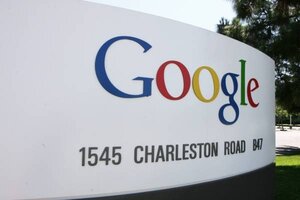Can Google Fast Flip bring print readers online?

Google's headquarters in Mountain View in Silicon Valley, Calif. On Monday, Google launched a visual search engine, Google Fast Flip, that lets readers flip through webpages of more than three dozen magazines and newspapers.
NEWSCOM
Quick on the heels of Bing (which launched a visual search engine based on images), Google released a new tool yesterday, Google Fast Flip, in hopes of recreating the print reading experience online.
The visual-search experiment lets readers "flip" through newspaper and magazine Web pages that are sorted according to the most viewed and recent stories as well as recommended articles and headlines. Readers can also sift through pages by a particular news organization or magazine and peruse articles by topic of interest.
Google launched Fast Flip in hopes of generating a new revenue model for the struggling publishing industry and to encourage more people to read news content online.
One of the main complaints about reading news online "is that browsing can be really slow," Krishna Bharat, a "Distinguished Researcher" for Google News, wrote in The Official Google Blog. "A media-rich page loads dozens of files and can take as much as 10 seconds to load over broadband, which can be frustrating. What we need instead is a way to flip through articles really fast without unnatural delays, just as we can in print. The flow should feel seamless and let you rapidly flip forward to the content you like, without the constant wait for things to load. Imagine taking 10 seconds to turn the page of a print magazine!"
Google has partnered with 36 magazine and newspaper publishers, who will receive revenue generated from ads on the site. Currently, the publishers include The New York Times, The Atlantic, Salon, The Washington Post, Newsweek, and ProPublica, according to The Official Google blog.
The BBC reports that other publications such as Cosmopolitan, Marie Claire, Elle, Popular Mechanics, and Slate, have signed on with Google. (Full disclosure: The Christian Science Monitor is one of the newspapers featured on Google Fast Flip.)
Google hopes that "being able to read articles faster means people will read more of them, driving more ad revenue to publishers," Bharat writes.
But by no means does Google believe Fast Flip is a "magic bullet" for the struggling publishing industry.
"[W]e believe that encouraging readers to read more news is a necessary part of the solution.We think Fast Flip could be one way to help, and we're looking to find other ways to help as well in the near future," Bharat concluded.
Thought it's only been one day since Google Fast Flip launched, the big question is: Will people want to "flip" through their news or will they continue on with their current news consumption habits?
David Coursey of PC World finds that it's much easier to scan through Google News rather than reading articles on Google Fast Flip. Still, he says Google Fast Flip provides an alternative to reading "search driven" Google News stories:
The good thing about Fast Flip is that it is publication oriented rather than being entirely search driven like Google News. This will solve some of the issues Gnews has with repeating the same stories over-and-over and occasionally replacing updated news with older stories that have somehow captured its robotic attention.
––
Crop circles, Google Earth, and the logo mystery
On Google’s homepage today, the search giant swapped out its normal logo for a UFO-themed Google doodle. The illustrated flying saucer carved out “Goog e” in the corn field, and a little green tractor finishes off the “l.” Such logo swaps are common for the tech titan, but what are they celebrating? Most of these “doodles” are tied to a particular anniversary or celebrity birthday. Why crop circles? Why today?
––
Share your thoughts on Google Fast Flip below or follow us on Twitter.
